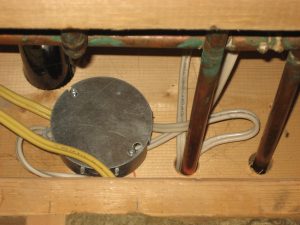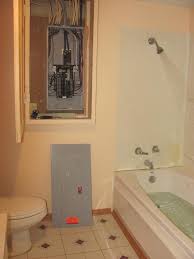Here are some pictures of Common Electrical Deficiencies found by the Alliston Home Inspector during actual home inspections.
Common Electrical Deficiencies found during Home Inspection
Many newer homes have renovated basements which the home owner has done the electrical work himself. You are allowed to do your own electrical work but you are required to have it inspected. One of the common defects found is walls constructed with metal studs without using the proper attachment hardware. You are not allowed to make your own grommets or standoffs but must use a CSA or similarly approved product. One solution which I have seen in many installations is to simply install a wood stud attached to metal stud where support is needed for cables.
In commercial applications this is never a problem because all the wiring is metal stud walls is armored cable.
I have included some common electrical code requirements for those “do it your self” electricians. Remember you must have your work inspected prior to enclosing walls and ceilings with drywall etc.
The home inspection defect picture clearly shows romex cables in contact and penetrating metal stud wall without proper bushings etc. Entire wall could become energized if the wire insulation failed.
Nonmetallic-sheathed cable shall be supported and secured by staples, cable ties, straps, hangers, or similar fittings designed and installed so as not to damage the cable, at intervals not exceeding 1.4 m (41⁄2 ft) and within 300 mm (12 in.) of every outlet box, junction box, cabinet, or fitting. Flat cables shall not be stapled on edge. Sections of cable protected from physical damage by raceway shall not be required to be secured within the raceway.
ESA Bulletin (2) Installation of NMSC in metal stud construction Rule 12-516(2) permits the use of non-metallic-sheathed cable with metal stud construction. Where NMSC is used in metal stud construction the following are installation requirements: • Approved inserts (grommets) to protect the cable where it passes through the metal stud. The inserts referred to in Rule 12-516(2)(b) must be approved for the purpose and adequately secured in place. • Round inserts are approved for a given size opening in a steel stud. If inserts are loose fitting or can be easily removed, they are not adequate for that installation and shall be replaced or installed in properly sized holes. • The improperly installed inserts can lead to cable insulation failures. Installation of NMSC in steel stud construction will not be accepted where the standards of workmanship or the type of inserts used results in the inserts not staying in place. • The cable must have adequate mechanical protection. Protection plates are required in all locations where NMSC is within 32 mm from the edge of steel studs in accordance with Rule 12-516(1).
Common Electrical Deficiencies – Reversed Polarity
The Alliston Home Inspector will check the polarity of outlets throughout the home during a home inspection. Many times electrical outlets will the power and neutral wires reversed, which is know as reversed polarity.
An electrical outlet should be wired so the HOT lead is connected to the correct side of the outlet, and the neutral lead to the other. This is done for safety reasons. Switches on the things you plug into the outlet will open and close the HOT side, so when the switch is off, there will be no voltage inside the device.
The HOT side, should be the smaller of the two openings on the outlet. The neutral will be the wider of the two. Cords where it matters will have one of the prongs wider so the neutral side and hot side line up correctly.
For example if you were to have a light with reversed polarity, the base where the light screws into, which is normally safe to touch, now becomes Hot and you will receive a shock if touched. Also any appliance can be “Hot” even when switch is shut off.
When wiring an electrical outlet the screws are colour coded for easy identification. The Brass Screw, which is the darker one, is where the Black or Hot wire is connected. The White Screw, or lighter one, is where the neutral is connected. With the widespread use of push in wire connectors most home owners never give polarity and thought and just push the two wires into the two holes. Bingo, reversed polarity, just like going to the Casino, a fifty fifty chance of getting it right. Reversed polarity is a serious safety and shock hazard and should be repaired immediately by a qualified and licensed electrician.
When multiple electrical deficiencies are present in an area of the home it is an immediate Red Flag that there most likely was no Building Permit taken out for renovations.
Common Electrical Deficiencies – Bathrooms
Many times I have come across a main panel board located in a basement bathroom. According to the Canadian Electrical Code this is not permitted. 
Rule 26-402 Location of Panelboards
Subrule (1) Panelboards shall not be located in coal bins, clothes closets, bathrooms, stairways, high ambient rooms, dangerous or hazardous locations, nor in any similar undesirable places.
If you are looking at purchasing a new home and it has a panel board located in the bathroom, then you know an licensed electrician never did the work and the electrical installation was never inspected. Another item which is very rare but strangely enough was discovered in a brand new home, is the height of the panel board. The handle of main disconnect or any circuit breaker shall not be more than 1.7 m above finished floor level. This deficiency was found in one of the new properties Bremont Homes is building in Innisfil. This type of defect would typically have been picked up during your Pre-Delivery Inspection of home. Bremont Homes does not allow you to bring a home inspector to you Pre-Delivery inspection, even though the Tarion website specifically states you are allowed to.
Interior vs Exterior Electrical Wire
Romex electrical cable, your typical white plastic cable, has an insulated outer jacket but the interior ground wire is typically not insulated which could interfere with the connection if water, gas, oil or solvent penetrated the jacket. Most inspectors will not allow Romex to be used to wire outdoor outlets, fixtures or other exterior items for the home. If in doubt check with your local Electrical Safety Authority. Some older homes will possibly have aluminum wiring, which has inherent safety issues.
Extension Cords
Extension cords are for temporary connections and are not designed as a replacement for permanent wiring. Do not hook up garage door opener, fridge, a/c units, sump pumps, furnaces, lights or any permanent fixture using an extension cord. Have a licensed electrician install an electrical outlet at the required location. Note: New home construction now requires an outlet for every overhead door opening in the garage.
Visit ESA the regulating and inspection authority in Ontario
Electrical Service Requirements can vary depending on use of building when it was built. Professional Commercial Building Inspections
Whether Residential or Commercial, Structural Deficiencies require Designer or Architect to repair safely. Read About Common Structural Deficiencies
Read about the Home Inspection Process to understand the steps your Home Inspector takes to create and Accurate Home Inspection Report
About the Alliston Home Inspector
